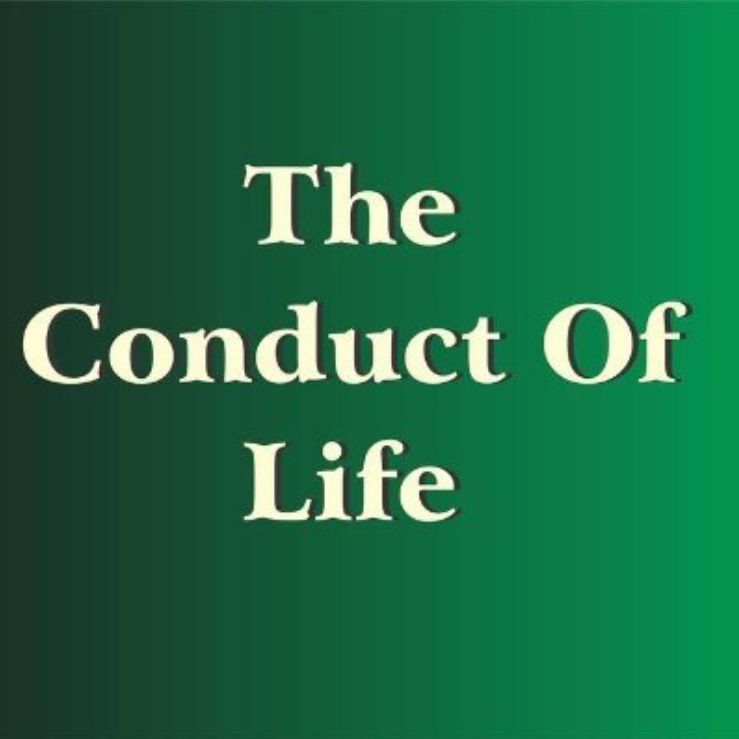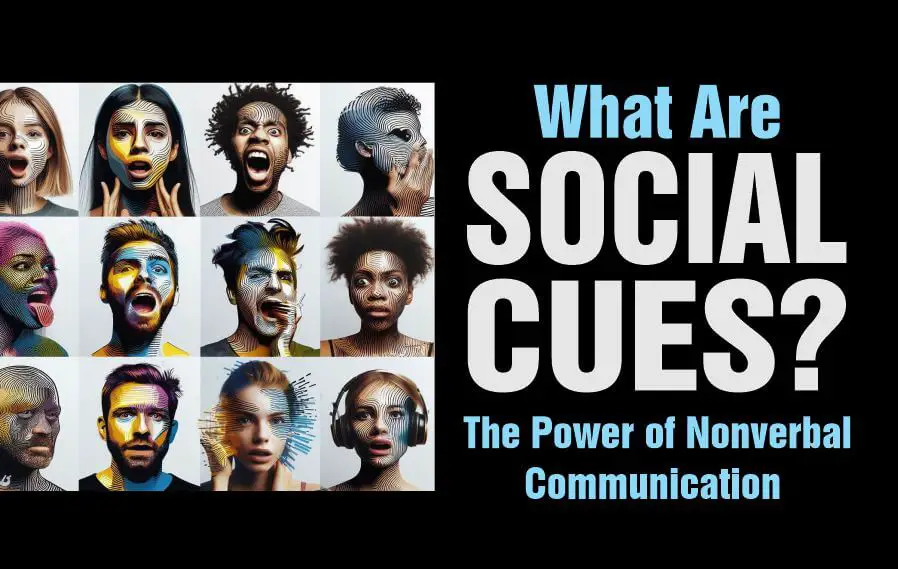Last updated on January 31st, 2025 at 09:14 am
Social cues are nonverbal and verbal signals that people use to communicate their thoughts, feelings, and intentions in social situations.
They can include facial expressions, body language, tone of voice, eye contact, and gestures and can be an indication of social intelligence.
Nonverbal communication can be intentional or unintentional, and it can convey a wide range of emotions and messages.
For example, a smile can be a social cue that indicates happiness or friendliness, while a frown can indicate sadness or disapproval.
Eye contact can be a social cue that indicates interest or attention while avoiding eye contact can indicate discomfort or disinterest.
Body language, such as posture and gestures, can also convey social signals, such as confidence, nervousness, or aggression.
Understanding nonverbal communication is an important aspect of social skills through interpersonal intuition, as it allows you to interpret and respond appropriately to social situations.
People who are skilled at reading social signals are often better able to navigate social situations, build relationships, and communicate effectively with others.
Related: Low Emotional Intelligence Signs, Causes
Table of Contents
- Importance of Understanding Social Cues
- Types of Social Cues
- The Power of Nonverbal Communication
- Examples of Nonverbal Cues in Different Social Settings
- Consequences of Lack of Social Cues
- Tips to Understanding Social Cues
- The Role of Social Cues in Social Intelligence Test
- Interpreting Social Cues
- Applications of Social Cues
- Frequently Asked Questions
- Final Thoughts
Importance of Understanding Social Cues

Understanding social cues is important for effective communication and building relationships with others.
It provides important information about your thoughts, feelings, and intentions, and can help you to interpret and respond appropriately to social situations.
Here are some reasons why understanding social signals is important:
Improved communication: Understanding social cues helps adjust communication styles to match others’ needs, enhancing clarity and effectiveness in conversations.
Building relationships: Understanding nonverbal cues fosters stronger connections, trust, and rapport, leading to deeper and more meaningful relationships.
Navigating social situations: Recognizing social signals helps you read situations accurately, understand norms, and engage appropriately in interactions.
Resolving conflicts: Social cues allow you to grasp others’ perspectives, facilitating conflict resolution and working toward mutually beneficial outcomes.
Career success: Social cue awareness improves professional relationships, enhances communication with colleagues and clients, and supports navigating workplace dynamics.
Related: Why You Need to Take the Social Intelligence Test
Types of Social Cues
Nonverbal communication covers a wide range of nonverbal signals that people use to communicate and interpret social information.
The types of social cues include:
Facial Expressions: Facial expressions, like smiles and frowns, communicate emotions such as happiness, anger, and surprise.
Body Language: Body language, including gestures and posture, conveys meaning such as defensiveness or receptiveness in interactions.
Tone of Voice: Tone, pitch, and intonation express emotions; a warm tone signals approachability, while a harsh tone signals tension.
Eye Contact: Eye contact shows interest, attention, and sincerity, indicating engagement and confidence during conversations.
Proxemics: Proxemics involves personal space usage, with cultural differences affecting how space is interpreted in communication.
Touch: Touch conveys emotions from comfort to aggression, playing a key role in empathy and rapport building.
Related: Social Awareness Skills and Development
The Power of Nonverbal Communication

The power of nonverbal communication is profound, influencing interpersonal relationships, perception, and behavior in various social settings.
Impact of Nonverbal Cues on Interpersonal Relationships
Nonverbal cues play a crucial role in shaping interpersonal relationships.
They can convey emotions, establish rapport, and build trust without a single word being spoken.
For instance, a warm smile, a comforting touch, or maintaining eye contact can create a sense of connection and understanding between individuals.
Conversely, negative nonverbal cues, such as crossed arms or averted gaze, can create barriers and hinder effective communication.
Also Read: EQ vs IQ – Why Emotional Intelligence Matters More
How Nonverbal Communication Influences Perception and Behaviour
Nonverbal communication significantly influences how you are perceived and how you behave in social interactions.
People often form impressions of others based on their nonverbal cues, such as body language, facial expressions, and tone of voice.
These perceptions can impact how you are approached, understood, and responded to in various social contexts.
Additionally, you may adapt your behavior based on the nonverbal cues you receive, adjusting your communication style and emotional responses accordingly.
Related: How Social Awareness Can Combat Social Injustice
Examples of Nonverbal Cues in Different Social Settings

Nonverbal cues manifest in diverse social settings, influencing the dynamics of communication and interaction.
In a professional setting, a firm handshake and confident posture can convey professionalism and competence.
In social gatherings, nonverbal cues such as nodding in agreement, maintaining open body language, and mirroring others’ gestures can encourage a sense of camaraderie and mutual understanding.
Even in public speaking or presentations, nonverbal cues like gestures, facial expressions, and vocal modulation can captivate an audience and enhance the delivery of the message.
Examples of Common Social Signals
Social cues are nonverbal and verbal signals that people use to communicate their thoughts, feelings, and intentions in social situations.
Here are some examples:
Facial expressions: Smiling, frowning, raising eyebrows, squinting, etc.
Body language: Posture, gestures, hand movements, etc.
Eye contact: Maintaining eye contact, avoiding eye contact, etc.
Tone of voice: Loud, soft, high-pitched, low-pitched, etc.
Verbal cues: Words used, tone of voice, etc.
Touch: Hugging, shaking hands, patting on the back, etc.
Proximity: The distance standing one is to someone.
Appearance: Clothing, grooming, etc.
Time: Punctuality, waiting, etc.
Silence: Pausing, not speaking, etc.
Related: The Role Of Social Awareness In Conflict Resolution
Consequences of Lack of Social Cues
A lack of understanding of social signals can have negative consequences in personal and professional relationships.
Here are some examples:
- Misunderstandings: Misinterpreting nonverbal communication can lead to misunderstandings and miscommunication. This can cause confusion, frustration, and even conflict in relationships.
- Difficulty building relationships: A lack of understanding of social signals can make it difficult to build relationships with others. People may perceive the individual as uninterested or unapproachable, which can make it challenging to form connections.
- Social isolation: A lack of social skills can lead to social isolation, as individuals may struggle to connect with others and form meaningful relationships.
Related: Witty Banter: The Art Of Clever Conversations
- Poor communication: A lack of understanding of social signals can lead to poor communication, as individuals may struggle to express themselves effectively or understand the needs and perspectives of others.
- Career setbacks: Poor social skills can also have negative consequences in the workplace. Individuals who struggle to read social cues may have difficulty communicating effectively with colleagues and clients, which can lead to misunderstandings and missed opportunities.
- Mental health issues: A lack of social skills can also contribute to mental health issues, such as anxiety and depression. Social isolation and difficulty forming relationships can lead to feelings of loneliness and low self-esteem.
Suggested: How To Overcome Social Awkwardness
Tips to Understanding Social Cues

Here are some tips to help you understand social signals:Observe: Pay attention to facial expressions, body language, and tone to better understand others’ thoughts, feelings, and intentions.
- Practice active listening: Focus on both what is said and how it’s said to pick up subtle social cues.
- Ask questions: Clarify uncertainties by asking, helping to avoid misunderstandings and strengthen relationships.
- Seek feedback: Request feedback from trusted individuals to identify areas for improvement in social gestures.
- Practice empathy: Put yourself in others’ shoes to better understand their perspectives and respond appropriately.
- Learn about social norms: Understanding cultural and situational norms improves your ability to interpret and respond to social cues.
- Seek professional help: Consult a therapist or counselor for strategies to enhance social skills and navigate interactions.
Recommended: Why You Are Embarrassed When Others Falter
The Role of Social Cues in Social Intelligence Test
Social signals also play an important role in social intelligence tests, as they are a key component of social intelligence.
Social intelligence questionnaires often include questions or scenarios that require individuals to interpret behavioral cues, such as facial expressions, body language, and tone of voice.
For example, a question may ask the individual to identify the emotion being conveyed by a person’s facial expression or to interpret the meaning behind a particular gesture or tone of voice.
The ability to read and respond appropriately to social cues is an important aspect of social intelligence, as it allows individuals to navigate social situations more effectively, build stronger relationships, and communicate more effectively with others.
By including questions or scenarios that require individuals to interpret interpersonal cues, social intelligence tests can provide insight into an individual’s social awareness and ability to read and respond to the social signals of others.
Related: What Is Social Awareness?
Interpreting Social Cues
Interpreting nonverbal cues involves the art of reading and responding to nonverbal signals in social interactions.
It covers understanding the nuances of nonverbal communication and using this understanding to navigate interpersonal relationships effectively.
The Art of Reading and Responding to Social Cues
Interpreting social signals requires attentiveness and sensitivity to nonverbal signals such as body language, facial expressions, and tone of voice.
It involves not only recognizing these cues but also responding appropriately to convey understanding and empathy.
This art of reading and responding to nonverbal communication is essential for building rapport, resolving conflicts, and fostering positive interactions.
Common Misconceptions and Challenges in Interpreting Nonverbal Communication
Misconceptions and challenges in interpreting nonverbal communication can arise due to cultural differences, individual variations in nonverbal expression, and the complexity of nonverbal cues.
For example, a gesture or expression that holds a specific meaning in one culture may convey a different message in another.
Additionally, individuals may exhibit conflicting nonverbal cues, making interpretation challenging.
Misconceptions about nonverbal communication can lead to misunderstandings and misinterpretations in social interactions.
Tips for Improving Social Cue Interpretation Skills
Improving social cue interpretation skills involves developing awareness, empathy, and cultural sensitivity. Some tips for enhancing these skills include:
- Practicing active listening to better understand nonverbal cues during conversations.
- Observing and learning about cultural differences in nonverbal communication to avoid misinterpretations.
- Paying attention to congruence between verbal and nonverbal cues to gain a more accurate understanding of others’ messages.
- Seeking feedback from trusted individuals to gain insight into one’s own nonverbal communication and interpretation skills.
- Engaging in role-playing exercises or social skills training to practice interpreting and responding to nonverbal cues in various scenarios.
Related: The Role of Emotional Awareness in Non-verbal Communication
Applications of Social Cues
Practical applications of understanding social signals and nonverbal communication extend to enhancing professional and personal relationships, conveying empathy and confidence, and influencing various real-life scenarios.
How Understanding Social Cues Can Enhance Professional and Personal Relationships
Proficiency in interpreting nonverbal communication can significantly enhance professional and personal relationships.
In the workplace, understanding nonverbal communication can aid in building rapport with colleagues, clients, and superiors, leading to improved teamwork, negotiation, and leadership.
In personal relationships, the ability to read and respond to social cues fosters empathy, trust, and effective communication, strengthening bonds and resolving conflicts.
Using Nonverbal Communication to Convey Empathy, Confidence, and Understanding
Nonverbal communication serves as a powerful tool for conveying emotions and intentions.
By understanding and utilizing nonverbal cues effectively, individuals can convey empathy, support, and understanding in both professional and personal contexts.
Additionally, nonverbal cues such as maintaining eye contact, using open body language, and modulating tone of voice can project confidence and assertiveness, influencing how one is perceived and received by others.
Frequently Asked Questions
What are the power of nonverbal cues?
The power of nonverbal cues lies in their ability to convey emotions, intentions, and attitudes, influencing interpersonal relationships and communication dynamics.
What are the three cues of nonverbal communication?
The three cues of nonverbal communication are body language, facial expressions, and vocal intonation.
What are the nonverbal cues of social interaction?
Nonverbal cues of social interaction include gestures, eye contact, and proxemics (use of personal space).
What is the role of nonverbal cues in social perception?
Nonverbal cues play a crucial role in shaping how individuals are perceived, influencing impressions, attitudes, and responses in social interactions.
Final Thoughts
Social cues and nonverbal communication are integral to human interaction, shaping perceptions, emotions, and relationships.
Understanding and interpreting these cues is essential for effective communication, empathy, and rapport building in both personal and professional settings.
The power of nonverbal communication lies in its ability to convey emotions, intentions, and confidence, influencing the dynamics of social interactions.
By honing the art of reading and responding to social cues, you can enhance your communication skills and cultivate meaningful connections in diverse social contexts.
References;
- https://www.verywellhealth.com/social-cues-5204407
- https://www.linkedin.com/pulse/power-nonverbal-communication-why-matters-every-bryce-purnell
- https://www.helpguide.org/articles/relationships-communication/nonverbal-communication.htm
Pyo Merez (PsyD) is a distinguished adolescent and adult psychologist at the forefront of mental health advocacy.
With expertise in cognitive and developmental psychology, focusing on social relationships, cultural contexts, and individual differences, Pyo has dedicated his career to empowering adolescents and adults.
As a sought-after speaker and panelist, Pyo shares invaluable insights on issues affecting young people, contributing to a deeper understanding of mental health and well-being in today's society.


